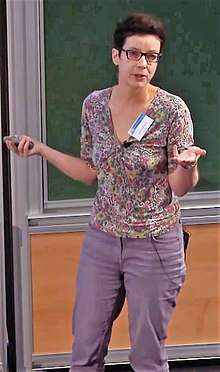Anne Osbourn
Anne Elisabeth Osbourn OBE FRS[1] is a professor of biology and director of the Norwich Research Park industrial biotechnology alliance at the John Innes Centre,[2] where she investigates plant natural product biosynthesis. She recognised that in the plant genome, the genes involved with biosynthesis organise in clusters. She is also a popular science communicator, and founder of the Science, Art and Writing (SAW) Initiative.[3]
Anne Osbourn | |
|---|---|
 Osbourn lectures on "Mechanisms of chemical diversification in plants" in 2015 | |
| Born | Anne Elisabeth Osbourn |
| Education | Bingley Grammar School |
| Alma mater | Durham University University of Birmingham |
| Scientific career | |
| Fields | Natural products |
| Institutions | John Innes Centre University of East Anglia Sainsbury Laboratory New Phytologist |
| Thesis | Host adaptation and variation in septoria nodorum (1985) |
| Website | www |
Early life and education
Osbourn grew up in West Yorkshire.[4] Her parents both studied and lectured English literature[4] and her father served in the army during World War II.[4] She became interested in plants as a child and she attended Bingley Grammar School and graduated in 1979. She earned a bachelor's degree in botany at Durham University.[5] At the time, researchers worked out how to transform the Rhizobium nitrogen fixation genes into the bacterium Escherichia coli.[4] Osbourn moved to the University of Birmingham for her doctoral studies on host adaptation in Septoria nodorum, supervised by Chris Caten.[4] She has described the Salem State University educationalist Louise Swiniarksi as her 'anchor throughout my adult life'.[4]
Research and career
Osbourn moved to Norwich in 1985, working at the John Innes Centre and Sainsbury Laboratory.[6] As of 2019 Osbourn is a Professor at the John Innes Centre, where she is also Director of the Norwich Research Park Industrial Biotechnology Alliance. She looks at how natural products interact with natural organisms.[7] Her early work looked at saponins and their role in plant defence.[8][9] Osbourn studies natural product biosynthesis. In particular, she has worked on the biosynthesis of triterpene. She identified that metabolic pathways organise in operon-like clusters, which allowed her to develop a novel opportunity to discover natural product pathways through genome mining. The natural products include terpenes, which can be used in the pharmaceutical industry as well as food and manufacturing.[10][6] Her research has been funded by the Biotechnology and Biological Sciences Research Council (BBSRC).[11]
Public engagement and honours
She was appointed to the UEA Creative Writing Course as a Nesta dreamtime fellow in 2004. Here she wrote poetry about her life as a plant scientist.[12][13] Osbourn became a popular science writer, and founded the Science, Art and Writing (SAW) Initiative.[4][14][3][15] Young scientists from elementary schools in the UK and China take part in the SAW initiative.[4] In 2016 Osbourn took part in an international exchange with the Vietnam Academy of Science and Technology.[16]
Osbourn was elected to AcademiaNet in 2014.[17] She is an editor of the New Phytologist.[12] She has won various awards and honours, including the medal of the University of Helsinki. In 2019 Osbourn was elected as a Fellow of the Royal Society (FRS).[18][19] She is the thirtieth research who has been elected Fellow from the John Innes Centre.[18]
She was appointed Officer of the Order of the British Empire (OBE) in the 2020 New Year Honours for services to plant science.[20]
References
- "Anne Osbourn - Royal Society". Royalsociety.org. Retrieved 20 April 2019.
- Anne Osbourn publications from Europe PubMed Central
- Osbourn A (2008). "SAW: breaking down barriers between art and science". PLoS Biology. 6 (8): e211. doi:10.1371/journal.pbio.0060211. PMC 2525686. PMID 18752351.
- "Professor Anne Osbourn". John Innes Centre. 21 November 2018. Retrieved 18 April 2019.
- "Gazette, XXVII (ns) including supplement". Durham University. p. 45. Retrieved 13 May 2019.
- Anon (2005). "Multiple Campylobacter Genomes Sequenced". PLOS Biology. 3 (1): e40. doi:10.1371/journal.pbio.0030040. ISSN 1545-7885. PMC 539341.

- "Anne Osbourn at the 2014 DOE JGI Genomics of Energy & Environment Meeting". Youtube.com. DOE Joint Genome Institute. 23 April 2014. Retrieved 19 April 2019.
- Osbourn, Anne (1996). "Saponins and plant defence — a soap story". Trends in Plant Science. 1 (1): 4–9. doi:10.1016/S1360-1385(96)80016-1. ISSN 1360-1385.

- Bouarab K, Melton R, Peart J, Baulcombe D, Osbourn A (2002). "A saponin-detoxifying enzyme mediates suppression of plant defences". Nature. 418 (6900): 889–92. Bibcode:2002Natur.418..889B. doi:10.1038/nature00950. PMID 12192413.

- Boutanaev AM, Moses T, Zi J, Nelson DR, Mugford ST, Peters RJ, Osbourn A (2015). "Investigation of terpene diversification across multiple sequenced plant genomes". Proceedings of the National Academy of Sciences of the United States of America. 112 (1): E81-8. Bibcode:2015PNAS..112E..81B. doi:10.1073/pnas.1419547112. PMC 4291660. PMID 25502595.
- BBSRC author. "Portfolio Analyser". Bbsrc.ukri.org. Retrieved 18 April 2019.
- Osbourn A (October 2015). "Anne Osbourn". The New Phytologist. 208 (1): 23–5. doi:10.1111/nph.13616. PMID 26311283.
- Osbourn A (January 2006). "The poetry of science". Nature Reviews. Microbiology. 4 (1): 77–80. doi:10.1038/nrmicro1321. PMID 16357863.

- "SAW antibiotics book launch, October 2017 » The SAW Trust". Sawtrust.org. Retrieved 18 April 2019.
- Osbourn, Anne (2009). "A meeting place: The Science, Art and Writing initiative". Current Science. 97 (11): 1547–1554. ISSN 0011-3891. JSTOR 24107294.
- "Professor Anne Osbourn | Royal Society". Royalsociety.org. Retrieved 18 April 2019.
- "Prof. Anne Osbourn - AcademiaNet". Academia-net.org. Retrieved 19 April 2019.
- Hill, Chris (2019). "Scientists honoured during 'golden age of discovery' at Norwich Research Park". Edp24.co.uk. Eastern Daily Press. Retrieved 19 April 2019.
- "Professor Anne Osbourn elected as Fellow of the Royal Society". John Innes Centre. 17 April 2019. Retrieved 19 April 2019.
- "No. 62866". The London Gazette (Supplement). 28 December 2019. p. N14.
- "06.414 - Root-Specific Promoters | PBL Technology". Pbltechnology.com. Retrieved 19 April 2019.
- "Enzymes involved in triterpene synthesis - Patent US8614369 - PubChem". Pubchem.ncbi.nlm.nih.gov. Retrieved 19 April 2019.